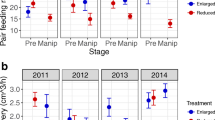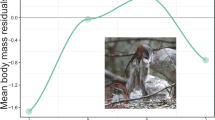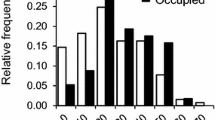Abstract
In avian families, some offspring are rendered unequal by parental fiat. By imposing phenotypic handicaps (e.g., via asynchronous hatching) upon certain of their offspring and not others, parents structure the sibship into castes of advantaged “core” offspring and disadvantaged “marginal” offspring that results in an asymmetric sibling rivalry. Here, I show how this family structure scales up to population level reproductive consequences. In a 17-year study of red-winged blackbirds (Agelaius phoeniceus), I show that year-to-year variation in the number of surviving offspring is driven primarily by variation in the number of marginal offspring at hatching and their posthatching survival. Clutch size, core brood at hatching, and fledging varied little from year to year and had little direct effect on year-to-year variation in total brood size at fledging; conversely, variation in the size of the marginal brood at hatching and at fledging was much greater. Marginal but not core brood size at hatching rose with mean clutch size; in years where parents laid larger average clutches they did so by adding marginal progeny. The mean posthatching survival of marginal offspring was always lower than that of core offspring in a given year, and there was no overlap in the distributions. The highest mean survival of marginal offspring across years fell below the lowest mean survival of core offspring; broods were deeply structured. There was an overall female bias among fledglings, and the sex ratio varied across years, with a higher proportion of the smaller female nestlings in years of below average reproductive success. Such variation was especially pronounced in the marginal brood where a higher incidence of brood reduction allowed greater potential for sex-biased nestling mortality. In years of the highest average reproductive success, the sex ratio in the marginal brood approached equality, whereas in years of the lowest average reproductive success, more than two thirds of 8-day-old nestlings were female. Structuring the brood into core and marginal elements allowed parents to modulate both offspring number and sex under ecological uncertainty with direct consequences for population-level reproductive success. They produced fewer and less expensive fledglings in below average years and more and more expensive fledglings in above average years.








Similar content being viewed by others

References
Beletsky L (1996) The red-winged blackbird: the biology of a strongly polygynous songbird. Academic, New York
Christians JK (2002) Avian egg size: variation within species and inflexibility within individuals. Biol Rev 77:1–26
Clark AB, Wilson DS (1985) The onset of incubation in birds. Am Nat 125:603–611
Eising CM, Muller W, Groothuis TGG (2006) Avian mothers create different phenotypes by hormone deposition in their eggs. Biol Lett 2:20–22
Fiala KL (1981) Sex ratio constancy in the red-winged blackbird. Evolution 35:898–910
Fiala KL, Congdon JD (1983) Energetic consequences of sexual size dimorphism in nestling red-winged blackbirds. Ecology 35:898–910
Forbes S (2009). Portfolio theory and how parent birds manage investment risk. Oikos (in press)
Forbes S, Glassey B (2000) Asymmetric sibling rivalry and nestling growth in red-winged blackbirds. Behav Ecol Sociobiol 48:413–417
Forbes LS, Thornton S, Glassey B, Forbes M, Buckley NJ (1997) Why parent birds play favourites. Nature 390:351–352
Forbes S, Glassey B, Thornton S, Earle L (2001) The secondary adjustment of clutch size in red-winged blackbirds (Agelaius phoeniceus). Behav Ecol Sociobiol 50:37–44
Forbes S, Grosshans R, Glassey B (2002) Multiple incentives for parental optimism and brood reduction in blackbirds. Ecology 83:2529–2541
Glassey B, Forbes S (2002) Begging and asymmetric nestling competition. In: Wright J, Leonard ML (eds) Evolution of nestling begging: competition, cooperation and communication. Kluwer Academic, Dordrecht, pp 269–281
Haigh CR (1968) Sexual dimorphism, sex ratios and polygyny in the red-winged blackbird. Ph.D. Thesis, University of Washington, Seattle
Hall M, Blount J, Forbes S, Royle N (2009) Does oxidative stress mediate the trade-off between growth and self-maintenance in structured families? Functional Ecology, in press
Holcomb LD, Twiest G (1970) Growth rates and sex ratios of red-winged blackbird nestlings. Wilson Bull 82:294–303
Hurlbert SH (1984) Pseudoreplication and the design of ecological field experiments. Ecol Monogr 54:187–211
Laux LJ (1970) Nonbreeding surplus and population structure of the red-winged blackbird (Agelaius phoeniceus). Ph.D. Thesis, University of Michigan, Ann Arbor, MI
Loehlin JC (1992) Latent variable models: an introduction to factor, path, and structural analysis (2nd ed.). Lawrence Erlbaum Associates, New Jersey
Magrath RD (1990) Hatching asynchrony in altricial birds. Biol Rev 95:587–622
Mock DW, Forbes LS (1995) The evolution of parental optimism. Trends Ecol Evol 10:130–134
Mock DW, Parker GA (1997) The evolution of sibling rivalry. Oxford University Press, Oxford
Nero RW (1984) Redwings. Smithsonian Institution Press, Washington
Reed WL, Turner AM, Sotherland PR (1999) Consequences of egg-size variation in the red-winged blackbird. Auk 116:549–552
Royle NJ, Surai PF, Hartley IR (2003) The effect of variation in dietary intake on maternal deposition of antioxidants in zebra finch eggs. Funct Ecol 17:472–481
Weatherhead PJ (1985) Sex ratios of red-winged blackbirds by egg size and laying sequence. Auk 102:298–304
Weatherhead PJ, Teather KL (1991) Are skewed fledgling sex ratios in sexually dimorphic birds adaptive? Am Nat 138:1159–1172
Weatherhead PJ, Dufour LW (2000) Fledging success as an index of recruitment in red-winged blackbirds. Auk 117:627–633
Weatherhead PJ, Dufour LW (2005) Limits to sexual size dimorphism in red-winged blackbirds: the cost of getting big? Biol J Linn Soc Lond 85:353–361
Weatherhead PJ, Robertson RJ (1977) Harem size, territory quality, and reproductive success in the red-winged blackbird (Agelaius phoeniceus). Can J Zool 55:1261–1267
Weatherhead PJ, Muma KE, Maddox JD, Knox JM, Dufour KW (2007) Morphology versus molecules: sexing red-winged blackbird nestlings. J Field Ornithol 78:428–435
Westneat DF, Clark AB, Rambo KC (1995) Within-brood patterns of paternity and parental behavior in red-winged blackbirds. Behav Ecol Sociobiol 37:349–356
Williams TD (1994) Intraspecific variation in egg composition in birds: effects on offspring fitness. Biol Rev Camb Philos Soc 68:35–59
Acknowledgments
This work would not have been possible without the assistant of a large and talented group of student assistants over the years. Space does not allow me to acknowledge them all but I would like to thank in particular the following members of the Swamp Crew: Kristin Tuchscherer, Kristjana and Jessie Lee Cameron, Nagu Atmuri, Dobryan Tracz, Dean Swedlo, Saumya Jayakumar, Aaron Trachtenberg, Leanne Grieves, James Rogers, Jodi Griffith, Suzanne Thornton, Richard Grosshans, and Barb Glassey. I thank German Avila-Sakar for help with structural equation modeling and Douglas Mock for many enjoyable days developing the concept of the structured family. This work was made possible by funding from the Natural Sciences and Engineering Research Council of Canada.
Author information
Authors and Affiliations
Corresponding author
Additional information
Communicated by S. Pruett-Jones
Rights and permissions
About this article
Cite this article
Forbes, S. Family structure and variation in reproductive success in blackbirds. Behav Ecol Sociobiol 64, 475–483 (2010). https://doi.org/10.1007/s00265-009-0863-x
Received:
Revised:
Accepted:
Published:
Issue Date:
DOI: https://doi.org/10.1007/s00265-009-0863-x



